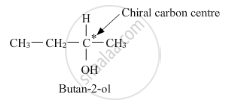Advertisements
Advertisements
प्रश्न
Why is Butan-1-ol optically inactive but Butan-2-ol is optically active?
उत्तर
Butan-2-ol has a chiral centre, that is, butan-2-ol has a carbon atom bonded to four different substituents.

Thus, it is optically active. On the other hand, butan-1-ol does not have any chiral carbon atoms.

Therefore, it is optically inactive.
APPEARS IN
संबंधित प्रश्न
When a coordination compound CoCl3.6NH3 is mixed with AgNO3, 3moles of AgCl are precipitated per mole of the compound. Write
(i) Structural formula of the complex
Indicate the types of isomerism exhibited by the following complex and draw the structures for these isomers:
[Co(en)3]Cl3
Draw all the isomers (geometrical and optical) of [CoCl2(en)2]+.
Write all the geometrical isomers of [Pt(NH3)(Br)(Cl)(py)] and how many of these will exhibit optical isomers?
Identify the optically active compounds from the following:
(i) \[\ce{[Co(en)3]^{3+}}\]
(ii) \[\ce{[trans - [Co(en)2Cl2]^+}\]
(iii) \[\ce{cis - [Co(en)2Cl2]^+}\]
(iv) \[\ce{[Cr(NH3)5Cl]}\]
The complex [(Pt(Py)(NH3)BrCl] will have how many geometrical isomers?
Indicate the types of isomerism exhibited by the following complexes and draw the structures for these isomers: [Pt(NH3)(H2O)Cl2]
Indicate the types of isomerism exhibited by the following complex and draw the structure for these isomer: \[\ce{[Pt(NH3)(H2O)Cl2]}\]
Indicate the types of isomerism exhibited by the following complexes and draw the structure for these isomer:
\[\ce{[Pt(NH3)(H2O)Cl2]}\]
Indicate the type of isomerism exhibited by the following complex and draw the structure for the isomer:
\[\ce{[Pt(NH3 )(H2O)Cl2]}\]
